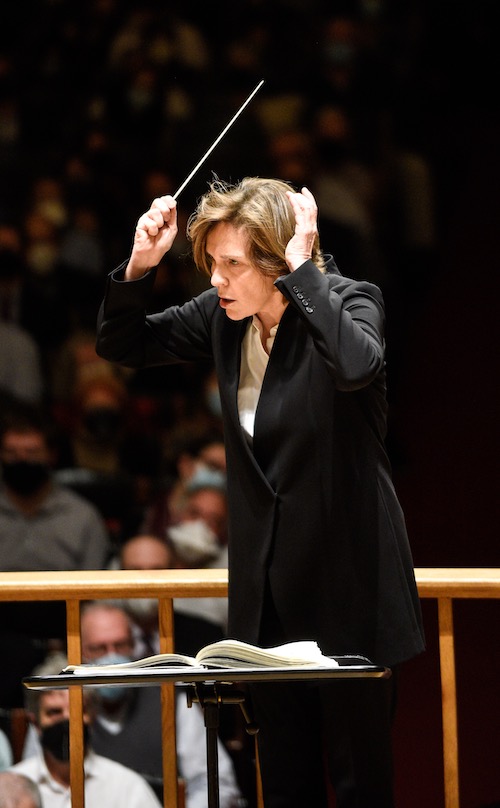Equilbey makes impressive Handel & Haydn debut with Farrenc and Beethoven

Laurence Equilbey conducted the Handel and Haydn Society Friday night at Symphony Hall. Photo: Sam Brewer
Despite a trailblazing career as pianist, pedagogue, and composer, Louise Farrenc’s music has mostly languished since her death in 1875. Recent years, though, have seen an uptick of interest in her work.
On Friday, the Farrenc revival made its way to Symphony Hall, courtesy of the Handel and Haydn Society and Laurence Equilbey. Making her debut with the ensemble, the Paris-based conductor led H&H’s first performance of Farrenc’s Symphony No. 3 alongside Ludwig van Beethoven’s familiar Symphony No. 6 (“Pastoral”).
Completed in 1847, the G-minor Third Symphony was the last of Farrenc’s five orchestral works (in addition to three symphonies, there are two overtures). Its four movements are undeniably related to the models of Mozart and early Beethoven, drawing on the forms and structures of the Classical-era symphony.
However, Farrenc’s writing is anything but stuffy. Her writing is abundantly contrapuntal and her melodic ideas often luminous. The music bristles with personality: the Third’s Scherzo, for instance, is diabolically playful. And her handling of the orchestra is never less than radiant, particularly the writing for woodwinds.
On Friday, Equilbey’s reading of the Third ably emphasized those latter qualities. Indeed, they’re evident from the first movement’s downbeat: the short introduction is essentially a sequence of calls-and-responses between strings and winds. In Equilbey’s hands, these unfolded with beguiling warmth before tumbling into the hurly-burly of the movement proper.
There, the music’s rhythmic profile was vigorously etched. But for all the intensity of the strings’ tone and the moxie of H&H’s delivery of the score’s slashing attacks, Equilbey’s account never lost sight of the music’s inherent, dancing qualities or its lyrical impetus. Even in the movement’s busiest moments, Farrenc’s melodic writing sang.
It did so, too, in the serene second movement. Here, led by principal clarinet Eric Hoeprich’s soaring solos, Equilbey drew a reading from the musicians that was unaffected, finely textured, and underlined by subtly voiced turns of harmony.
In the tautly articulated Scherzo, she drew a range of colors from her forces, particularly during the mellifluous Trio. And the finale was defined by playing of stormy athleticism, especially over its development and coda.
Taken together, this was an impressively shaped and directed Farrenc Third, Equilbey drawing out its nuances of dynamics, balance, and character while never losing sight of the score’s larger musical aims.
Those qualities also defined the performance of Beethoven’s “Pastoral” Symphony. While the work may be well-known, this 1808 composition, which depicts a day spent in the country, is breathtakingly inventive, full of unexpected turns of harmony, instrumentation, phrasing, and gesture.
Equilbey’s fluent performance Friday was highlighted by smart tempo choices, close attention to musical detail, and a strong understanding of each movement’s character.
The first, with its frolicsome air, big dynamic range, and focused development, moved purposefully. So did the burbling second section where the H&H’s musicians’ pellucid playing emphasized the astonishing details of Beethoven’s orchestral writing, including some striking instrumental combinations (particularly for viola and bassoon sections).
The portrait of a village gathering was brawny indeed, while Jonathan Hess’s timpani interjections thundered mightily during the ensuing thunderstorm depiction. The concluding “Shepherd’s Song” was radiant, flowing, and cathartic.
Afterwards, Equilbey and H&H offered a short encore of music from Beethoven’s incidental music to The Ruins of Athens. After the richness of the night’s programmed offerings, this felt a mite superfluous. Yet, given the vitality of the orchestra’s playing on Friday night, it was welcome all the same.
The program will be repeated 3 p.m. Sunday at Symphony Hall. handelandhaydn.org; 617-266-3605
Posted in Performances
